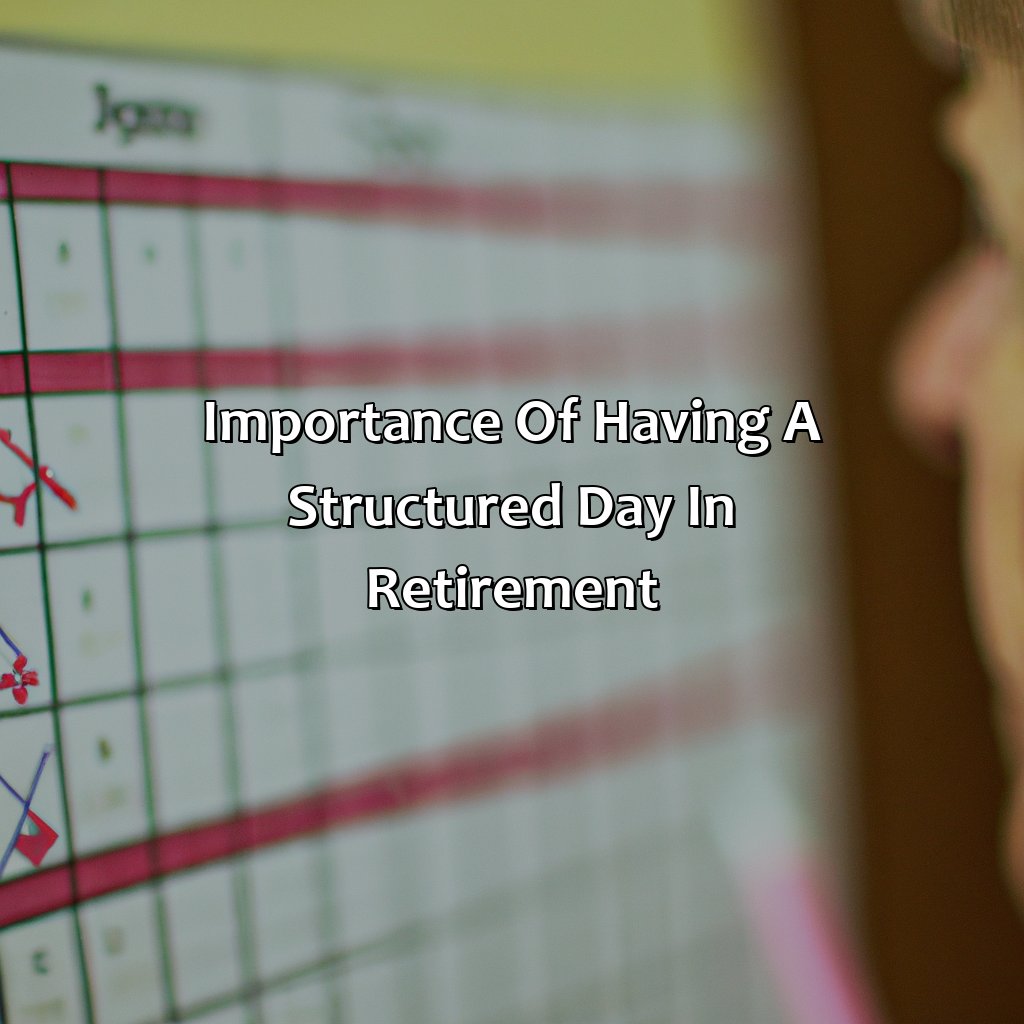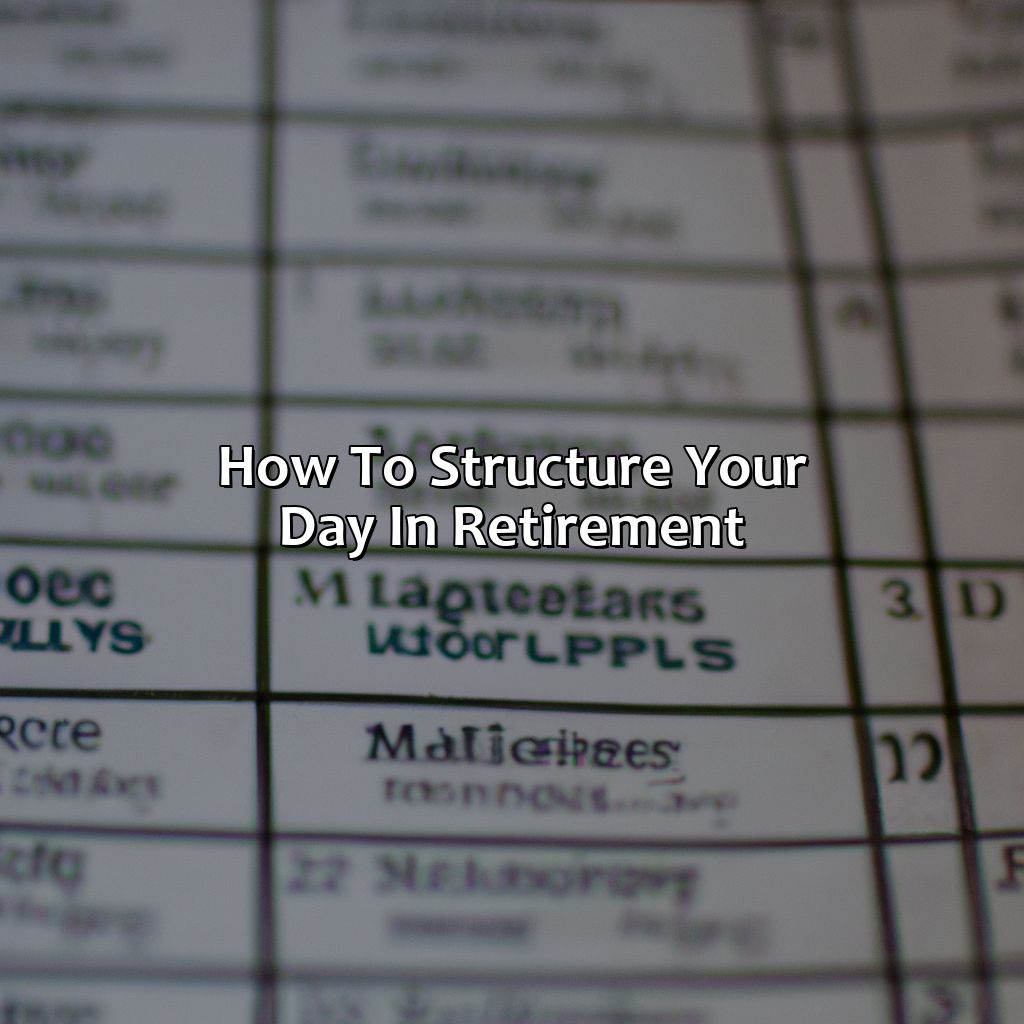How To Structure Your Day In Retirement?
Key Takeaway:
- It’s important to have a structured day in retirement: Having a routine helps retirees maintain their physical and mental health and prevents boredom and a sense of purposelessness.
- When structuring your day, consider incorporating physical activity, social interaction, and pursuing hobbies or interests: Staying physically active can reduce the risk of chronic illness and improve mood, social interaction can combat loneliness and depression, and engaging in hobbies or interests can provide a sense of fulfillment and enjoyment.
- Consider developing a daily routine that includes a morning routine, afternoon routine, and evening routine: A structured routine can help retirees stay organized and focused and can provide a sense of stability and purpose in retirement.
Feeling stuck in retirement? You deserve to make the most out of your days. Here’s how to structure your day in retirement for optimal joy and productivity.
Importance of having a structured day in retirement
Structured Routines in Retirement: Benefits and Tips
Maintaining a structured day in retirement becomes paramount as it provides seniors with a sense of purpose and fulfillment. When retirees create a routine, they can better manage their time, prioritize activities, and balance physical and mental health. A structured routine can also facilitate social connections and ensure engagement in meaningful activities, making it easier to maintain a positive outlook on life.
To build an effective daily routine in retirement, start with identifying your priorities and setting specific goals. Incorporate activities that bring joy, such as pursuing hobbies, volunteering, or spending quality time with loved ones. It is essential to include physical activity, exercise, and stretching to ensure a healthy body and mind. Finally, it is equally important to set aside time for relaxation and rest, as it promotes better sleep patterns and helps release stress.
One unique challenge in retirement is the temptation to slip into monotony and boredom. Therefore, it is crucial to be intentional about incorporating variety and seeking new experiences. This helps keep the mind active, enhances creativity, and helps maintain a sense of purpose.
Research shows that structured routines benefit retirees’ overall well-being, leading to a happier and healthier life. According to a study by AARP, retirees with a sense of purpose were found to be more satisfied with their lives, more resilient, and had a lower risk of death. A structured daily routine is an essential tool for seniors to maintain an active, fulfilled and healthy lifestyle.

Image credits: retiregenz.com by James Jones
Factors to consider when structuring your day
Structuring your day in retirement? You’ve got to consider certain factors. Physical activity, social interaction and hobbies or interests can form the backbone of your daily routine. Making your retirement more fulfilling and enjoyable!
Let’s explore the factors, including physical activity, social interaction and hobbies/interests.

Image credits: retiregenz.com by Yuval Jones
Physical Activity
Maintaining Physical Fitness
Sustaining physical activity is crucial in any stage of life, particularly in retirement. Aim to keep active and include a range of exercises such as cardio, strength training, and stretching to improve heart health, maintain muscle mass, and flexibility. Staying active can also reduce joint pain and help support your mental well-being.
In addition to traditional workouts or sports, you can integrate movements into everyday activities like taking walks or doing housework. And it may be beneficial to try new activities such as dance classes or water aerobics.
It’s worth noting that the benefits of physical activity don’t come solely from structured exercise; maintaining an active lifestyle with things like outdoor gardening or walking can provide many rewards too.
A senior retiree named Bob spent significant time engaged in swimming daily after being diagnosed with arthritis. The practice not only helped him overcome joint stiffness but also made his retirement enjoyable by meeting new people at the poolside every day.
Remember, retirement doesn’t have to mean a life of solitude – unless you’re really into crossword puzzles and cats.
Social Interaction
Connecting with Others in Retirement
Maintaining social connections is crucial for retirees. Loneliness can be harmful to mental and physical health. Stay engaged and connected with family, friends, or community organizations for a sense of purpose and satisfaction.
Joining clubs or groups with like-minded interests provides an opportunity to build relationships and partake in activities. Volunteering your time is another way to connect with others while giving back to the community.
Furthermore, technology has made it easier than ever to connect virtually. Consider joining online communities or video chat apps to stay in touch with loved ones who live further away.
Making an effort to regularly schedule social events can help you maintain social interactions that benefit your overall well-being. Whether it’s meeting for coffee with a friend or attending a weekly book club, prioritize making connections as a crucial aspect of daily life.
Retirement: finally having time to pursue your hobbies, because let’s face it, golfing and napping can only fill up so many hours of the day.
Pursuing Hobbies/Interests
Engaging in Passions and Hobbies
Devoting time to personal interests and hobbies can be an enriching aspect of retirement life. Engaging in activities that provide a sense of joy and fulfillment can promote mental health, as well as foster a purposeful lifestyle. Pursuing passions such as painting, gardening or volunteering helps create structure within one’s daily routine while also promoting socialization.
It is important to choose activities that fulfill individual needs and interests. Finding new hobbies can be exciting, but one must also recognize the importance of maintaining previous passions throughout retirement. Engaging in physical activity such as walking or yoga can also improve overall well-being.
Through hobbies one may find meaning and community involvement beyond traditional work-life boundaries. A retiree may discover new talents during leisure time whilst experiencing a newfound feeling of worth and accomplishment.
A senior who enjoyed collecting art found himself with an overwhelming amount of paintings he had accumulated over the years. Instead of allowing them to collect dust, he organized an exhibition at his local gallery opening him up for recognition amongst his peers whilst fulfilling a lifelong dream because he pursued his passion for art even after retirement.
Retirement may mean the end of your career, but it’s the perfect time to start your career as a professional napper.
Daily Routine Suggestions
Retirement days can be structured with our daily routine suggestions! We have three segments for you: morning, afternoon and evening. These ideas should assist you to optimize your time and maintain a healthy balance between productivity and relaxation all day.

Image credits: retiregenz.com by David Woodhock
Morning Routine
Starting Your Day Right: Suggestions for A Productive Morning Ritual
Start your day strong by following these three simple steps:
- Wake up at the same time every day to establish a regular sleeping pattern.
- Drink a glass of water upon waking up to hydrate and signal your body that it’s time to start the new day.
- Spend some time doing light exercises, meditation, reading or any activity that you enjoy. This can help increase blood circulation, focus and set a positive tone for the rest of the day.
Create an optimum working environment by opening windows and curtains for natural light to enter the room or play some calming music to set-up a peaceful ambiance.
Starting your morning right could be realized in many ways, such as indulging yourself in a cup of coffee or tea while catching up with old friends through phone calls or video chats. These small gestures can positively impact our overall mood and maximize our productivity throughout the day.
Finally, establishing a consistent morning ritual might be challenging in retirement life, but adding this structure to each new day through simple routines can significantly improve physical and mental wellness.
Retirement is like a never-ending weekend, but with more naps and fewer hangovers.
Afternoon Routine
The afternoon is a critical time for retirees. Here’s how you can spend it productively:
- After Lunch Walk: Take a stroll, engage in light exercise, and soak up the sun.
- Creative Time: Choose an activity that inspires you, such as painting or writing.
- Learn Something New: Enroll in a course online to develop new skills or pursue an old passion.
- Socializing: Spend time with friends and family or join clubs to build new relationships.
During your afternoon routine, make sure to strike a balance between mental and physical activities while also maintaining social connections.
Pro Tip: Resist the urge to stay indoors all day by deliberately scheduling outdoor activities during the afternoon hours.
Evening Routine
As the day comes to an end, it’s crucial to establish a pattern to ensure a good night’s sleep. An effective ‘Bedtime Routine’ can contribute significantly to your overall well-being.
- Prepare for bed: Pick out your nightwear, brush your teeth, and perhaps take a warm shower.
- Disconnect from technology: Stay away from phones, laptops, and TVs at least an hour before bed.
- Relaxation Techniques: Indulge in meditation or gentle stretches to calm down.
- Read a book: Engage in some light reading that would facilitate peaceful thoughts before sleep.
- Lights out: Ensure the bedroom environment is dark, peaceful and let slumber prevail.
It’s important to stick with the routine regularly to establish healthy sleeping habits. Improving the quality of sleep will impact your energy levels throughout the day.
Here’s a pro-tip! Opting for a 10-minute mindfulness practice right before hitting the sack can work wonders for inducing sound sleep!
Some Facts About How To Structure Your Day in Retirement:
Having a daily routine can help retirees maintain a sense of purpose and structure. (Source: Forbes)
It is important to make time for physical activity and exercise in retirement. (Source: Mayo Clinic)
Many retirees find it beneficial to pursue hobbies or take on part-time work to stay engaged and active. (Source: U.S. News)
Building social connections and maintaining relationships with friends and family is crucial for overall well-being in retirement. (Source: Harvard Health Publishing)
Creating a balance between leisure and productivity can help retirees lead a fulfilling and satisfying retirement. (Source: Investopedia)
FAQs about How To Structure Your Day In Retirement?
What are some tips for structuring your day in retirement?
One tip for structuring your day in retirement is to make a schedule. Start each day with a plan, including things like exercise, meal times, and hobbies. Another tip is to get involved in your community or volunteer work.
Why is it important to structure your day in retirement?
Having structure in your day can help you maintain a sense of purpose and prevent feelings of boredom or isolation. It can also help you stay physically and mentally active.
How much structure should I have in my day?
The amount of structure in your day will depend on your personal preferences and lifestyle. Some retirees prefer a more structured schedule, while others enjoy a more relaxed approach. It’s important to find the balance that works best for you.
Can adding structure to my day in retirement benefit my health?
Yes, adding structure to your day can have numerous health benefits. It can help you maintain a healthy sleep schedule, promote physical activity, reduce stress levels, and stimulate your brain.
What are some common mistakes to avoid when trying to structure your day in retirement?
Some common mistakes to avoid when trying to structure your day in retirement include overscheduling yourself, not allowing for flexibility, and neglecting your social life. It’s important to find the right balance and make adjustments as necessary.
What are some fun activities I can include in my daily schedule?
There are many fun activities you can include in your daily schedule, such as taking a walk, practicing a hobby, reading, socializing with friends, attending a fitness class, or trying a new recipe. The key is to find activities that you enjoy and that promote a sense of fulfillment.
 Checkout this IRS Loophole
Checkout this IRS Loophole 




